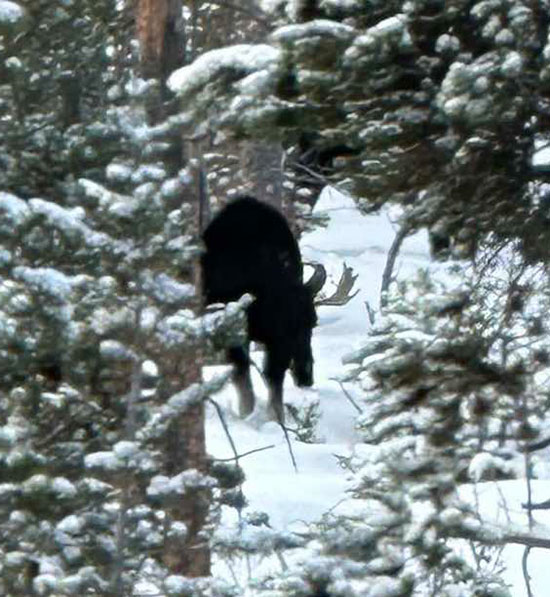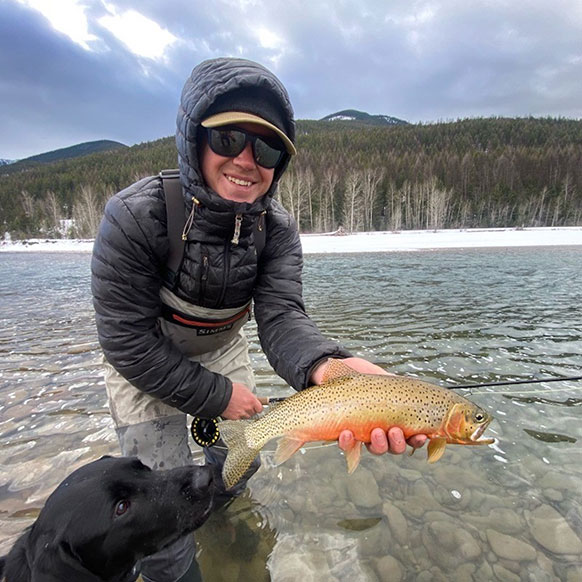No Slides Entered.
UW’s Biodiversity Institute Helps Coordinate Winter Moose Day Weekend Feb. 10-11
For those who like moose and want to try to spot one or maybe more, the public has two days to search -- by snowshoe or skis -- for the large mammals.
For the 10th year running, community scientists will be able to help track moose populations in the mountains outside of Laramie for Winter Moose Day. Coordinated, in part, by the University of Wyoming’s Biodiversity Institute, the event is scheduled Saturday-Sunday, Feb. 10-11, in the Vedauwoo/Happy Jack and Snowy Range Mountain areas. Registration will open Wednesday, Jan. 10, with the deadline to register Tuesday, Jan. 30. To register, go here.
“Having a weekend event -- rather than a one-day event -- is one of the protocol changes we made last year,” says Mason Lee, senior project coordinator for the Biodiversity Institute. “Surveyors can go out either Saturday morning or Sunday morning, whatever works best for their group.”
Volunteers adopt survey routes, and ski or snowshoe those routes to record all observations of moose or signs of moose. This can include tracks/hoof prints in snow, bed areas, scat droppings, and browse on aspen and willows. To survey while moose are most active, participants are asked to get to their routes as early as dawn and to complete their surveys by noon.
While observations of moose can still be voluntarily loaded into iNaturalist for public viewing, Lee says the Biodiversity Institute is no longer creating Moose Day projects on the website, a joint initiative of the California Academy of Sciences and the National Geographic Society.
“We made this change because we switched to using an app, Survey123, for volunteers’ data collection, which is a move away from the paper datasheets,” Lee says. “Photos have the ability to be added to that app or emailed to me.”
The same number of routes -- 17 in Pole Mountain, 12 in the Snowies and one in Arlington -- are available each year.
“We have not added any new routes, but one of the protocol changes we made last year was to allow multiple groups to independently survey the same route. This means that it is a possibility that Moose Day surveyors may encounter another Moose Day survey group on their route,” Lee says. “This is a good thing for the data that is being collected and helps make our results more rigorous. These multiple independent surveys help us better estimate detection probability of moose and moose sign.
“Despite how large moose are, they’re really good at hiding,” Lee continues. “So, just because an observer doesn’t report seeing a moose doesn’t mean the moose wasn’t there. Having multiple groups allows us to correct for this potential underestimation.”
Ideally, there would be at least one volunteer group to cover each of the 30 routes, Lee says. But, because some of the routes are more difficult to traverse or are farther away, all routes do not usually get adopted.
“For safety reasons, survey groups should consist of at least two people. Groups can be as large as people want,” Lee says. “When groups record their data on Moose Day, it is very important to provide the number of people who were in the group so that we can account for effort in the detection probability estimates.”
Because multiple groups can register to survey the same route, a lot more people can participate in Moose Day than in previous years, says Lee, who adds the surveyors are typically a mix of volunteers who participate each year as well as newcomers.
“Last year, we had around 40 groups participate in the surveys with an average of four people per group,” she says.
Data gathered from the Winter Moose Day is shared with biologists at UW. These biologists use the data collected by community scientists to further their understanding of the population densities of local moose, their reproductive rates, their winter ranges and how these variables change over time.
During the 2023 Winter Moose Day, 11 adult moose and one calf were observed, and many signs of moose -- scat, tracks, etc. -- were seen, Lee says. A record 19 moose – 15 adults and four calves were spotted during the 2022 Winter Moose Day.
Lee says that Winter Moose Day is often marked by strong winds or snowfall, both of which can obscure fresh tracks and signs of moose. This can result in few sightings of moose sign. However, volunteers are encouraged to collect weather and visibility information.
As of December 2023, the Wyoming Game and Fish Department estimated there were 3,660 moose in Wyoming, with moose populations gradually increasing. The estimate is based on surveys conducted annually by the department.
Both the winter and summer Moose Day events are geared toward increasing the public’s understanding of moose in the Laramie area and involving the public in asking and answering questions. These events are an extension of the original program, Moose Day, held by Nature Mapping Jackson Hole (NMJH) in Jackson each winter. NMJH is a citizen-science program created by the Jackson Hole Wildlife Foundation.
Required training for new participants is scheduled Saturday, Feb. 3, from 10 a.m.-noon in the Berry Biodiversity Conservation Center. Training includes a one-hour classroom session and a one-hour outside training component.
Share This Post

This moose was spotted in the Happy Jack area east of Laramie during Winter Moose Day 2023. Community scientists spotted 11 adult moose and one calf in the Snowy Range and Pole Mountain areas. Winter Moose Day is coordinated, in part, by the University of Wyoming’s Biodiversity Institute (Jennie Lawrence Photo)
Social Media
Latest News



Archives
- All
- December 2025
- October 2025
- August 2025
- July 2025
- June 2025
- May 2025
- April 2025
- March 2025
- February 2025
- January 2025
- November 2024
- October 2024
- September 2024
- August 2024
- July 2024
- June 2024
- May 2024
- April 2024
- March 2024
- February 2024
- January 2024
- December 2023
- November 2023
- August 2023
- July 2023
- April 2023
- September 2022
- August 2022
- July 2022
- June 2022
- May 2022
- April 2022
- March 2022
- February 2022
- January 2022
- December 2021
- November 2021
- October 2021
- September 2021
- August 2021
- May 2021
- April 2021
- March 2021
- October 2020
- August 2020
- July 2020
- January 2020
- March 2019

